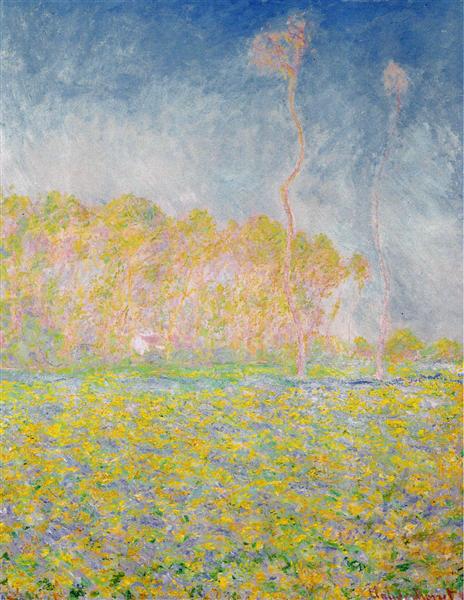Beschreibung
Claude Monet's painting "Spring Landscape," painted in 1894, embodies the essence of Impressionism, an artistic movement that Monet himself helped define. In this work, the artist manages to capture the freshness and vivacity of spring through his characteristic use of light and color, provoking in the viewer an almost palpable feeling of the season. In the composition, one can see an extensive green meadow that expands towards the background, marked by the presence of trees that still retain some of the pale leaves of winter, while spring buds begin to manifest themselves. This series of green tones, from the most subdued to the most intense, reinforces the idea of rebirth and growth that the season symbolizes.
One of the most notable aspects of Spring Landscape is its treatment of color. Monet uses a bright palette, dominated by greens and yellows, interpolating shades of blue that suggest the depth and atmosphere of the landscape. The brushstrokes are loose and rapid, giving the work an almost vibrant energy. This style suggests movement, as if the viewer could feel the gentle breeze caressing the meadow. Monet's technique, based on layering color and optical mixing, allows sunlight to appear to naturally pass through the scene, illuminating every corner with a glow that recalls the ephemeral nature of spring.
In the background, several trees can be seen, some of which are in bloom. Monet often found inspiration in the gardens and landscapes of his home in Giverny, where nature becomes the setting for his artistic exploration. In this case, the choice of spring is no coincidence; this is a representation of a moment of renewal not only in nature, but also in the life and work of the artist himself. There are no human figures in the work, which allows the landscape to speak for itself, emphasizing the intimate connection between man and nature that Monet sought to communicate. Looking at the work, one is led to meditate on the simplicity and beauty of everyday life, celebrated in those moments of light and color.
Through Spring Landscape, Monet also condenses the core ideas of Impressionism. He avoids meticulous details, prioritizing visual perception at a specific moment. This translates not only into the depiction of a landscape with flowers and vegetation, but also into the inherent emotionality that art can convey. Monet, furthermore, lightens the weight of realistic representation, allowing viewers to interpret the work through their own experiences and feelings.
The work is set within a period when Monet was experimenting with different lighting conditions and atmospheres. As in other works from the same period, his interest in seasonal change and the changes in light throughout the day is evident. Paintings such as "The Water Lilies" or "The Luncheon on the Grass" also reflect this commitment to the atmospheric study of his natural surroundings.
In conclusion, “Spring Landscape” is more than just a depiction of spring; it is a dialogue with the viewer about the fleeting beauty of life. The work conveys an innate joy through its vibrant palette and dynamic composition, highlighting Monet’s connection to nature and his mastery as a pioneer of Impressionism. In this constant cycle of rebirth and transformation that spring represents, Monet invites each viewer to lose themselves in the sensory experience of the landscape, reminding us of the importance of nature in our everyday world.
KUADROS ©, a famous painting on your wall.
Hand-made oil painting reproductions, with the quality of professional artists and the distinctive seal of KUADROS ©.
Painting reproduction service with satisfaction guarantee. If you are not completely satisfied with the replica of your painting, we will refund 100% of your money.

